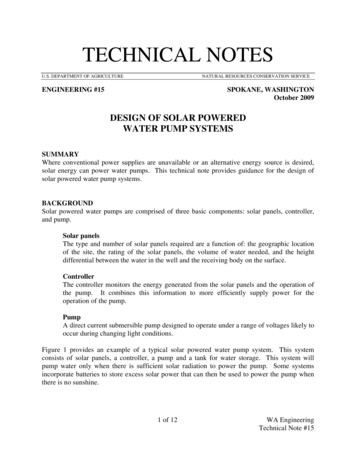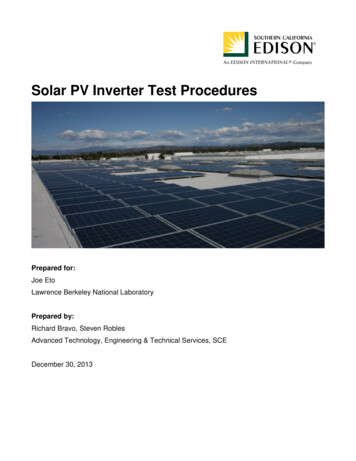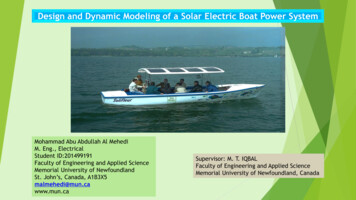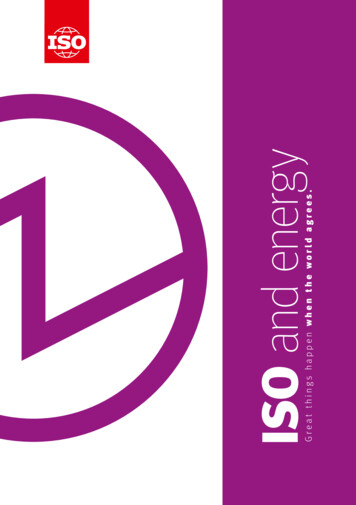
Transcription
POWER AND WATER CORPORATIONSOLAR/DIESELMINI-GRIDHANDBOOK
This project is supported by the Australian Government through the AustralianRenewable Energy Agency (ARENA). ARENA is an independent agency established tomake renewable energy technologies more affordable and increase the amount used inAustralia. ARENA is supportive of all renewable energy technologies and invests alongthe innovation chain – from research in the laboratory to large scale technology projects,as well as activities to capture and share knowledge. More information is available atwww.arena.gov.au.Power and Water Corporation (PWC), through its not-for-profit subsidiary IndigenousEssential Services Pty Ltd (IES), is responsible for the provision of energy, waterand wastewater services to 72 nominated remote Indigenous communities and66 outstations across the Northern Territory (NT). To service these communities,PWC operates over 50 isolated mini-grid power systems, most of which rely on dieselfuel for power generation.Electricity demand in remote NT communities is continuing to increase, as a result ofGovernment infrastructure development, service improvement and housing programsand population growth. At the same time the price of diesel fuel is highly volatile, beingaffected by global supply constraints and exchange rate movements. An ongoing relianceon diesel fuel for remote power generation represents considerable and increasingfinancial risk.
PWC is committed to delivering least-cost, reliable and safe electricity services to remoteIndigenous communities and has long pursued alternative energy source options. PWCrecognises the opportunity solar technologies present to reduce the reliance on dieselfuel and drive down operational expenditure.PWC has an over 20 year track record of owning and operating solar/diesel hybrid systemsin remote Indigenous communities. There are currently eight solar/diesel hybrid systemsservicing eleven communities. These incorporate a range of solar technologies includingconcentrating photovoltaic dishes and flat plate solar systems with an installed solarcapacity of over 1.7 megawatts. PWC is pursuing a step-change in its remote generationportfolio, with the hybridisation of the entire diesel mini-grid fleet to include solar.PWC is committed to industry knowledge sharing in order to strengthen the collectiveexperience and expertise in hybrid mini-grid system planning, implementation andoperation. This approach is intended to foster the ongoing development of high qualityintegrated, efficient solar/diesel hybrid power systems across Australia.DisclaimerThe Solar/Diesel Mini-Grid Handbook (the Handbook) was prepared by PWC under theDaly River Solar Research Project supported by the Australian Government throughARENA. The Handbook is disseminated in the interest of information exchange andgeneral guidance only. Neither PWC, nor ARENA, nor any of their employees makesany warranty, express or implied, or assumes any legal liability or responsibility for theaccuracy, completeness, or usefulness of any views, information or advice expressedherein or any apparatus, product or process disclosed. Reference herein to any specificcommercial product, process or service by trade name, trademark, manufacturer, orotherwise does not necessarily constitute or imply its endorsement, recommendation orfavouring by PWC or ARENA.p o w e r an d wat e r co r p o r at i o nSolar/Diesel Mini-Grid Handbook3
1 ACRONYMS1:Acronyms4
ARENA – Australian Renewable Energy AgencyAVR – Alternator voltage regulatorBOM – Bureau of MeteorologyCPV – Concentrating Solar PhotovoltaicsCSO – Community Service ObligationESO – Essential Services OperatorESS – Energy Storage SystemGHz – GigahertzGSS – TKLN Solar Project Grid Stability SystemHz – Hertz5IEA PVPS – International Energy Agency Photovoltaic Power Systems ProgramIES – Indigenous Essential Services Pty LtdkW – KilowattSolar/Diesel Mini-Grid HandbookkWh – Kilowatt hourLAN – Local area networkLCOE – Levelised Cost of EnergyMJ/m2 – Megajoules per metre-squaredMW – MegawattMWh – Megawatt hourMWp – Megawatt peakNPC – Net present costNPV – Net present valueNT – Northern TerritoryNTG – Northern Territory GovernmentO&M – Operation and MaintenancePPA – Power Purchase AgreementPWC – Power and Water CorporationRPM – Revolutions per minuteSCADA – Supervisory control and data acquisitionTKLN – Ti Tree, Kalkarindgi, Lake Nash (TKLN Solar Project)p o w e r an d wat e r co r p o r at i o n
2 CONTENTS2: Contents6
1ACRONYMS. 42CONTENTS.63 GLOSSARY OF DEFINITIONS. 84FOREWORD.12Acknowledgments. 1367INTRODUCTION.145.1Mini-Grid Definition. 155.2Northern Territory Context.16DIESEL MINI-GRIDS. 226.1Diesel Engines.236.2PWC Diesel Mini-Grids. 257SOLAR/DIESEL .1Quality of Supply Requirements.307.2.2Legacy Infrastructure.327.2.3Remoteness. 347.2.4Intermittency. 347.2.5System Financing.35Design Considerations.367.3.1Solar Penetration and Control.367.3.2Solar Resource, Climate and Technology Choice. 407.3.3Generators.467.3.4Energy Storage. 477.3.5Load Control.507.3.6Modelling Tools.537.3.7Other Factors. 588CONCLUSION. 609APPENDIX.629.1Remote Indigenous Communities Serviced by PWC.639.2Utility Scale Solar/Diesel Mini-Grids In Australia.649.3 Distributed Generation – Alice Springs Investigation.659.4Energy Storage Technologies.689.5 Load Management – Daly River Preliminary Investigation.709.6Load Management – Technologies.73p o w e r an d wat e r co r p o r at i o nSolar/Diesel Mini-Grid Handbook5
3 GLOSSARY OFDEFINITIONS3: Glossary of Definitions8
Agreed Service Levels: PWC has responsibility for the provision of reliable essentialservices (power, water and wastewater) to 72 remote Indigenous communities across theNT. The minimum service levels to be provided by PWC are based on the service outcomesthat would be expected in other similar sized and located communities in the NT. PWCreports to the NTG on performance against these minimum service levels however theyare not regulated by the NT Utilities Commission.Community Service Obligation (CSO): In the Handbook, the term CSO refers to thepayment the NTG provides to PWC in order to fund the shortfall between the costto supply electricity in remote Indigenous communities and the revenue recoveredfrom customers. Due to the increasing cost of providing electricity services to remotecommunities (associated with increasing diesel fuel cost, increasing electricity demand,increasing supply quality expectations and aging infrastructure), the shortfall gap(and hence the required CSO) is also increasing.Levelised Cost of Energy (LCOE): A constant unit cost ( /kWh or /MWh) of electricitysupplied that has the same present value as the total cost of building and operatingthe system over its life (typically 20 years). LCOE for hybrid solar/diesel systemsincorporates all ongoing system costs (for both solar and diesel infrastructure),however typically only includes the capital costs of the solar component. This is becausethe existing diesel infrastructure represents a ‘sunk cost’. There are multiple ways tocalculate LCOE, depending on the level of financial detail. LCOE is useful in comparingtechnologies with different operating characteristics; however results are highly sensitiveto input assumptions so they must be kept consistent across technologies to enable areasonable comparison.Load management: Refers to the context where the load is managed in order to optimisegenerator or network performance. In the Handbook, load management specificallyrelates to the direct controlling and interrupting of loads in order to optimise powersystem operation, for example to manage power station stability during times ofintermittent solar output.Minimum loading: Refers to the minimum recommended load factor (per cent) of a dieselengine. Diesel engines can be damaged by extended operation below the minimum loadfactor which may reduce engine performance and cause premature engine maintenanceor rebuilding. The minimum loading of diesel engines is a manufacturer-recommendedspecification and can be in the order of 40 per cent of name plate rating. Typically if theloading on an engine reaches the minimum load factor, the control system will call onlinea smaller generator, which is better suited to the load demand.Minimum runtime: Refers to the minimum length of time a generator must be onlinebefore the control system can take it offline. This setting ensures that small fluctuationsin load do not cause excessive cycling of generators, which induces unnecessary wear andtear on the engines.Mini-grid: Refers to an isolated power system which operates autonomously i.e. managesand controls line voltage and frequency, real and reactive power flow and balances powersupply with power consumption.Penetration: Solar penetration in hybrid mini-grid systems is typically classified by twonumbers: energy penetration and power penetration. Energy penetration (averagepenetration, [kWh/kWh]) is the fraction of total energy solar provides to the system,usually assessed on a per annum basis. Power penetration (instantaneous penetration,[kW/kW]) is the fraction of power solar provides instantaneously to the power system.For example, a solar system may reach 80 per cent instantaneous power penetration attimes and provide 30 per cent annual energy penetration overall.p o w e r an d wat e r co r p o r at i o n9Solar/Diesel Mini-Grid HandbookEnergy storage: Refers to a way of keeping a reserve of energy that can be used ata later stage. Typically energy storage is classified as either ‘long-term’ or ‘short-term’.Long-term energy storage is used to provide energy over long periods, such as overnightin small solar/battery systems. Short-term energy storage is used to provide powerover short periods, such as smoothing the intermittent output of a solar system in asolar/diesel mini-grid. There are various energy storage technology types suited todifferent applications including batteries, pumped hydro, compressed air, super-capacitorsand fly wheels.
3: Glossary of Definitions10Power Purchase Agreement (PPA): Refers to a contract between two separate entitiesregarding the supply and purchase of electricity. PWC utilises PPA contracts withindependent third parties for the supply of electricity to six remote Indigenouscommunities. Under these PPA models, PWC procures only kWh units from the third party.This means, crucially, that PWC is responsible for providing, maintaining and operatingthe distribution infrastructure in the community (i.e. the grid network) and providingretail services (including managing the connection and disconnection of services,metering and billing, supporting the connection of small-scale customer-owned solarPV systems, informing and educating customers about water and energy efficiency etc).Under the PPA models that relate only to the supply of solar energy (i.e. the TKLN SolarProject), PWC is responsible for the provision of reliable power overall. This means thatPWC continues to operate and maintain the diesel power station and all related powerdistribution infrastructure, as well as providing the aforementioned auxiliary services(retail, metering and billing etc). Under this model, PWC also ensure that sufficient dieselgeneration capacity exists to supply reliable power in the event that the solar powerstation is offline.Power station: Refers to the primary site of power generation in remote communitiesserviced by PWC. PWC operates over 50 mini-grid power stations, the majority of whichrely solely on diesel fuel for power generation. These power stations vary in size from300kW up to 5MW.Quality of supply: PWC is contracted to provide reliable, safe, utility-grade power witha minimum level of service that equals the service outcomes that would be expectedin other similar sized and located communities in the NT. PWC reports to the NTG onperformance against agreed minimum service levels, however remote community gridsare not regulated by the NT Utilities Commission.Remote Indigenous Communities: Refers to the 72 nominated remote Indigenouscommunities that PWC (via its not-for-profit subsidiary IES) is responsible for providingessential services (power, water, wastewater) to, on behalf of the NTG. For a map of theselocations, refer to Appendix 9.1.
Smoothing: Refers to the act of reducing the acuteness of solar output fluctuationsduring intermittent cloud events. This function is commonly provided by energystorage systems.Solar: In the Handbook the term ‘solar’ refers to solar photovoltaic (PV) technology, notsolar thermal technology.Solar/Diesel mini-grid: In the Handbook the term solar/diesel mini-grid describes ahybrid mini-grid power system using solar and diesel generation operating in a remoteIndigenous community serviced by PWC in the NT. The characteristics of these mini-gridsthat set them apart from other solar/diesel hybrid mini-grid systems operating in otherjurisdictions and internationally include: the pre-existence of a diesel power stationand associated legacy infrastructure, demand-driven supply expectations, centralisedgeneration and a uniform tariff. Attempts have been made to highlight where similaritiesexist between solar/diesel mini-grids in the NT and those that exist elsewhere.Spinning reserve: Refers to the amount of spare diesel generator capacity that is onlineand available to instantaneously service additional load. Spinning reserve is carried inorder to manage normal community load fluctuations. In the case of solar/diesel hybridsystems, additional spinning reserve may be required in order to service any unmet load inthe event of a reduction in solar output (such as during a cloud event).System cost: From a PWC perspective, system cost is based on the levelised cost ofenergy (LCOE), which means the lifetime cost electricity supply including construction,maintenance and fuel supply. System cost does not include ‘sunk costs’ such as theexisting diesel generators and associated infrastructure.Uniform tariff: The NTG operates a uniform tariff policy, which means that all(non-contestable) customers in the NT pay the same price for electricity ( /kWh).Due to the high cost of remote power generation, the revenue recovered from customersin remote communities via the uniform tariff does not represent full cost-recovery. TheNTG subsidises electricity for remote community customers via the CSO.p o w e r an d wat e r co r p o r at i o nSolar/Diesel Mini-Grid Handbook11
4: Foreword124 FOREWORDReliable power supply underpins all aspects of communitydevelopment and provides the foundation for all economicand social development objectives. While diesel fuel willcontinue to play a fundamental role in providing reliablepower supply to remote Indigenous communities, PWC’scommitment to least cost electricity service provision inremote communities is driving a progression to solar/dieselhybrid power systems.
It is intended that the Handbook be updated in future as solar, diesel and storagetechnologies improve and our collective knowledge and experience designing,implementing, operating and maintaining solar/diesel hybrid mini-grid systemsincreases. This includes the addition of case studies of projects delivered under theARENA Community and Regional Renewable Energy (CARRE) Program, providinginformation on technical system configuration, project outcomes and lessons learntas a knowledge sharing tool.It is also intended to further expand the Handbook scope to include other renewableenergy technologies and energy efficiency practices being implemented in mini-gridsacross remote Australia; to capture the state of knowledge and experience in systemdesign, implementation and operation and document specific current technical,regulatory, service standards, process and other requirements relating to off-grid energyservice delivery and specify where these requirements differ across jurisdictions. Otherkey information which may be included in future revisions are occupational healthand safety considerations, cultural awareness, material supply constraints, communityengagement and consultation, and system acceptance testing.AcknowledgmentsThanks are due to the following organisations who contributed to the development ofthe Handbook: Power and Water Corporation (Project Manager – Sara Johnston) Australian Renewable Energy Agency CAT Projects Centre for Renewable Energy, Charles Darwin University University of New South Wales Alaskan Centre for Energy and Power Epuron (owner of TKLN Solar Pty Ltd)p o w e r an d wat e r co r p o r at i o nSolar/Diesel Mini-Grid Handbook13
5: Introduction145 INTRODUCTIONIn recent years, the price of solar system components hasreduced to the point that solar/diesel hybrid generationhas now become economically viable for remote mini-gridgeneration in the NT, relative to diesel-only generation.Solar is fast becoming the lowest cost, lowest risktechnology option for reducing diesel fuel consumptionfor remote power generation.
The overarching objective of the Handbook is to provide information about the keytechnical, design, implementation and operational considerations when planning solar/diesel hybrid mini-grid systems in remote Australia. The Handbook is intended to be auseful reference tool for the Australian off-grid solar/diesel industry, to aid solar/dieselhybrid system decision making and assist renewable energy technology suppliers developand provide solutions for remote power generation. The Handbook provides a contextualoverview to new entrants in the solar/diesel mini-grid space, including on-grid solardevelopers keen to tap into the off-grid market and the general public interested in thechallenges and opportunities associated with ‘hybridising’ existing diesel mini-grids.Throughout the Handbook, case studies of existing hybrid systems have been cited todemonstrate application of the considerations and issues discussed. The primary casestudies referred to are the Daly River Solar Research Project and the TKLN Solar Project. Daly River Solar Research Project – a preliminary feasibility assessment of integratingsolar into the existing diesel power station at Daly River. TKLN Solar Project – implementation of high penetration solar into three existingdiesel mini-grids across the NT.5.1MINI-GRID DEFINITIONThe International Energy Agency defines a mini-grid as ‘a set of electricitygenerators and, possibly, energy storage systems interconnected to adistribution network that supplies the entire electricity demand of a localisedgroup of customers’. The term mini-grid is applied to power systems of varioussizes and levels of complexity however with increasing system size the operatingcharacteristics and constraints of mini-grids change. In order to distinguishbetween mini-grids of different scale three broad classifications of mini-gridsare recognised internationally:(1) Village micro-grids (e.g. rural electrification in developing countries,supplying limited power for basic needs)(2) Diesel mini-grids (e.g. isolated grids servicing remote Indigenouscommunities across Australia(3) Urban/industrial mini-grids (e.g. isolated grids servicing remote miningoperations; or sections of large urban grids which can disconnect from theurban grid and operate autonomously).The Handbook is focused on (2), specifically diesel mini-grids servicingremote Indigenous communities in the NT with generation capacity between300 kilowatts (kW) – 5 megawatts (MW).Further Information: IEA PVPS Task 11 – PV Hybrids and Mini-Grids produceda number of reports on the characteristics of hybrid mini-grids relativeto small-scale solar home systems and large urban electricity networks.These can be found at www.iea-pvps-task11.org/. IEA PVPS Task 11 is alsoa good source of information regarding the strengths and weaknesses ofsolar/diesel mini-grid system architecture options, including centralisedor decentralised generation; AC, DC or AC and DC coupling; and mini-gridcontrol methods. IEA PVPS is a good starting point for a literature reviewof international work in solar/diesel mini-grid systems.p o w e r an d wat e r co r p o r at i o n15Solar/Diesel Mini-Grid HandbookThere are a myriad of types and designs of mini-grid systems operating around theworld which have distinct attributes and constraints. Therefore, it is important to emphasisethat the Handbook is focused primarily on mini-grids owned and operated by PWC in the NT,servicing remote Indigenous communities on behalf of the Northern Territory Government(NTG). Throughout the Handbook, where content is relevant also for mini-grids operatingin other jurisdictions in Australia and/or internationally, attempts have been made tonote this in text boxes adjacent to the main text. In addition, key sources of informationaddressing other areas of the solar/diesel hybrid mini-grid spectrum not covered in theHandbook, such as reports published by the International Energy Agency Photovoltaic PowerSystems (IEA-PVPS), which may be of interest to readers have been highlighted.
5.2NORTHERN TERRITORY CONTEXTIn the NT, PWC via its not-for-profit subsidiary Indigenous Essential ServicesPty Ltd (IES) is responsible for the provision of reliable utility-grade electricityservices to 72 nominated remote Indigenous communities and 66 outstationsacross the NT. To achieve this, PWC operates and maintains over 50 dieselmini-grid power stations between 300kW and 5MW capacity with a totalinstalled diesel capacity of over 74MW and over 1 000km of power distributionlines. Of these mini-grid systems eight are solar/diesel hybrids, supplyingelectricity to eleven communities. These systems use a range of solartechnologies, including concentrating photovoltaic (CPV) dishes and flat platephotovoltaic (PV) solar systems and have an installed capacity of over 1.7MW.The key characteristics of PWC mini-grids are outlined below.5: Introduction16 Diesel is the primary source of power generation: this is the case even in thesolar/diesel hybrid systems operating. This is a key distinction from mini-gridswhose primary source of power is renewable energy (e.g. solar), with thediesel generators used solely as back-up or standby supply. This distinction hasoperation and design implications.
Generation is centralised: a single power station services the minigrid. In the case of hybrid solar/diesel systems, the solar power stationis situated adjacent to the diesel power station. While the level ofdistributed generation is increasing in remote communities (i.e.customer-owned rooftop solar), these systems are relatively small incomparison to the scale of the centralised diesel power station. There isno communications link between these systems and the power station;they are not controlled and essentially act as negative load. Full-automated control and SCADA: remote power systems are managedon a continuous automated basis. In most instances the solar-dieselsystem interface occurs in the power station and the solar feeder isconnected to the main switchboard, typically no loads are connected tothe solar feeder between the solar system and the switchboard.p o w e r an d wat e r co r p o r at i o nSolar/Diesel Mini-Grid Handbook17
PWC-owned: almost all mini-grid infrastructure and assets in major remoteIndigenous communities is owned by PWC including power stations,electricity distribution networks and fuel storage; the exception being somesolar power stations which are operated under a PPA with a third party. PWCis responsible for providing generation, distribution and retail functions toremote community customers. Quality of Supply: PWC is contracted to provide reliable, safe, utility-gradepower and meet service outcomes that would be expected in othercommunities of similar size and remoteness.5: Introduction18 Mini-grid design and operation is demand-driven: customer supplyexpectations are high and PWC must design and operate the power systemin order to satisfy customer demand. This is distinct from mini-grids whichare supply-driven whereby the design and operation are driven by theavailability of the solar resource and the size and operating costs of the dieselgenerator(s) (i.e. the supply). PWC is licensed by the NT Utilities Commission to provide electricity tocustomers in remote Indigenous communities and regulated retail electricityprices are set by the NTG. The NTG has a uniform tariff policy, meaning thatall non-contestable electricity customers pay the same electricity tariff.The electricity tariff is lower than the cost to produce electricity in remoteIndigenous communities. The cost to supply electricity services is much higher than revenue recoveredthrough tariffs. The NTG provides a subsidy to PWC in the form of acommunity service obligation (CSO) payment to fund the shortfall. The performance of the diesel mini-grid is not regulated by the UtilitiesCommission, however PWC is required to satisfy minimum service levels(acceptable voltage and frequency). PWC mini-grids are isolated systems i.e. they are not interconnected intolarger networks. PWC has interconnected remote Indigenous communitiesinto small regional mini-grid networks supplied by a single power station,where it has been economically efficient to do so.For more information regarding the operation of PWC’s remote mini-gridpower systems, refer to 6.2 PWC Diesel Mini-Grids. A map of the 72 remoteIndigenous communities serviced by PWC is included in Appendix 9.1.
CASE STUDY: DALY RIVER COMMUNITY SOLAR/DIESEL PRELIMINARYFEASIBILITY ASSESSMENTCOMMUNITY OVERVIEWDaly River (also known as Nauiyu Nambiyu) has a population of about6302 and is situated approximately 230 km south of Darwin on the banksof the Daly River. The Traditional Owners of the area are the Malak Malakpeople, who live both in Nauiyu Nambiyu and at Wooliana downstreamfrom the community3. Town services available in Daly River include a localstore, a health clinic, two primary schools and an air strip. Every year inMay a sports carnival and art show with an evening concert attract up to5 000 visitors. Renowned fishing competitions are held at Daly River thatalso attract many visitors to the community.ARAFURA SEABATHURSTISLANDMELVILLEISLANDCOX PENINSULADARWINBATCHELORTIMOR SEAADELAIDE RIVERDALY RIVERPINE LFOFCARPENTARIATIMBER CREEKBORROLOOLATINETABLELANDSBUN
experience and expertise in hybrid mini-grid system planning, implementation and operation. This approach is intended to foster the ongoing development of high quality integrated, efficient solar/diesel hybrid power systems across Australia. Disclaimer The Solar/Diesel Mini-G










